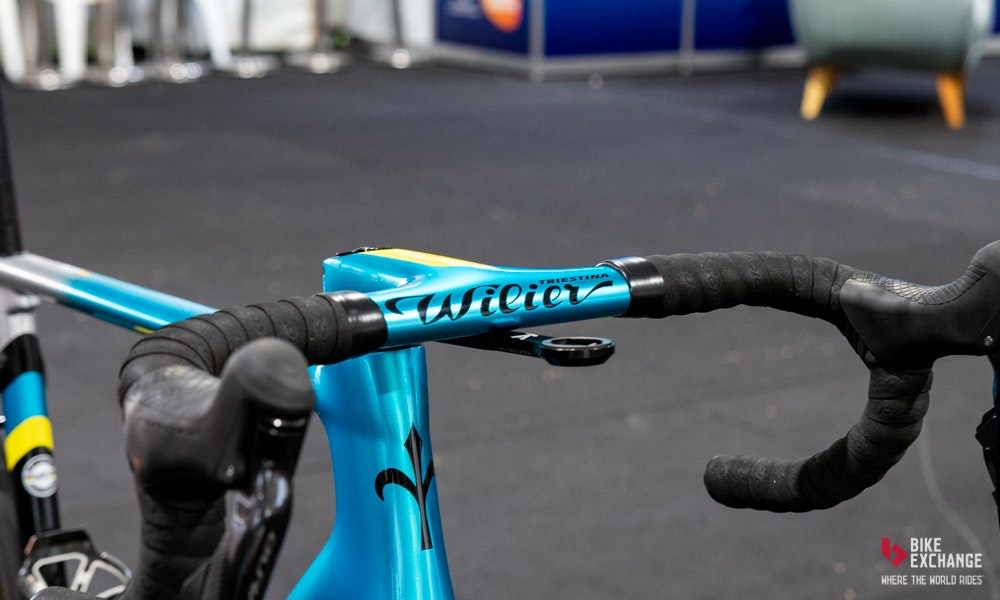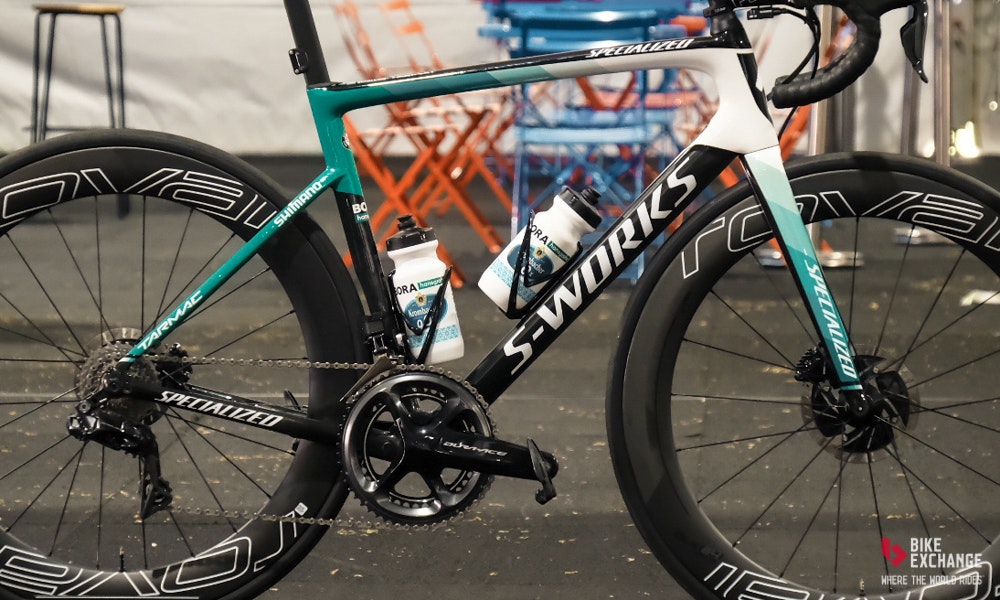With the Tour Down Under representing the first chance to see the pedals turned in anger for 2020 UCI WorldTour, cycling fans and media descend on the city of churches to get a glimpse of the updated kits, new teams, fresh faces and slick bikes. So as is now tradition, we snuck our way into the Team pits to get a closer look at the bikes of the Pro's
This year we're doing things a little differently, in this article, we'll take you through the tech that goes into the bikes of the Pro's and detail how you can get your hands on some WorldTour bike tech of your own!
- Related Reading: Road Bike Groupsets Explained
Frames:

The bikes of the WorldTour pro's go to great lengths to remove and unnecessary weight, as such, they're manufactured from carbon fibre. As per UCI regulations, complete bikes in the world tour are required to weigh in at 6.8kgs as a minimum. It's no secret that many bikes in the peloton could easily dip under this weight figure, particularly the feathery bikes of climbers. As a result, it's not uncommon to see weights, or heavier components added to the bikes to bring them up to spec.

The riders have several lightweight bikes at their disposal, and nothing personifies a race bike quite like the Cannondale SuperSix Evo. Updated in 2019, the SuperSix Evo is the American outfit's all-around race machine and is the bike of choice when the road points up for EF Education First.

With aero/lightweight bikes becoming increasingly popular in the last 12 months, some riders are forgoing other bikes for a sprint stage, or hilly days, opting for one bike to rule them all. One such team opting for that approach is Kazakh squad Astana. Utilising the recently released Wilier Triestina SLR Zero, the squad is opting for a wheel change rather than a bike change, which is sure to please the team mechanics.

When it comes to aero bikes, no other bike in the peloton personifies winning quite like the Specialized Venge. The big S claimed at its launched in 2018 the most winningest aero bike in the peloton, with riders such as Julian Alaphillippe, Peter Sagan, and Sam Bennett all previously racking up famous victories on the steed, it's not difficult to see why. The Venge of Deceunink-Quickstep fast man Sam Bennett pictured is arguably amongst the lightest aero bikes in the peloton, tipping the scales at a touch over 7kg on our scales.
Wheels

When it comes to wheelsets in the pro peloton, it's a sea of carbon fibre as far as the eye can see. Teams and riders are spoiled for choice when it comes to wheelsets, often having a range of depths available to them from their wheel supplier.
Most of the rides we spied at this year's Tour Down Under opted for a best of bost worlds approach, selecting a wheel around 50-60mm in depth. Wheels at this depth will typically provide an aerodynamic benefit, helping riders cruise along on the flats, while still being light enough to allow them to spin up a climb.

On flatter days, expect to see riders run wheel depths over 60mm. While these hoops will be more substantial than their shallower counterparts, the additional aerodynamic efficiency awarded negates any weight penalty that may be present. Conversely, on climbing stages with plenty of elevation on the parcours, the focus shifts to minimising rotational weight at the rim. While this allows riders to dance up the climbs seemingly unencumbered, these svelte hoops aren't as adept in the aerodynamics department as their deeper brethren.
Tyres

The tyres used in the pro peloton are often the fastest rolling rubber that money can buy. While some rolling stock such as the popular Continental Pro LTD tubular isn't available, the remainder of the teams make use of tyres open to the public, albeit at a cost. Tubular tyres are often the go-to for pro riders; however, they often lack everyday functionality for those of us riding in the real world.
Tubular tyres still utilise an inner tube, but its sewn into the tyre rather than sitting separately from it, like a clincher. As a result, tubular tyres need to be stuck to the wheel via glue or special tape. The key benefit of sticking the tyre directly to the rim is that in the event of a flat, the tyre will stay on the rim, allowing the rider to continue to roll without losing control.

Tubeless tyres like those picture above are starting to become increasingly popular in the peloton, particularly in races that traverse rougher terrain such as the cobbled classics. In addition to increased puncture resistance compared to tubular tyres, tubeless tyres provide outstanding rolling resistance and can be run at lower pressures, improving traction, comfort and control.
Groupsets

Arguably the most critical part of a pro ride, the bike's groupset is responsible for transferring a rider's power from their legs to the road below. As a result, the groupsets used in the pro peloton need to be reliable, precise, lightweight and durable.

The groupsets themselves are made up of a host of parts including the chainrings, power meter, crank arms, chain, cassette, shifters and derailleurs. While some teams have complete sponsorship from the likes of Shimano, SRAM and Campagnolo, other teams have the flexibility to pick and choose their components in search of those all-important marginal gains.

Power meters are another component that are sponsored items for teams. A device once reserved to the likes of professionals, now riders of all abilities levels can benefit from them. Power meters make use of strain gauges to measure power exerted from the rider's legs, taking the force applied on the component and then calculating the combination of this torque and angular velocity to give a number measured in watts.
Modern power meters will talk to your cycling computer or even your smartphone with Bluetooth, so you can view your power in real-time, as well as upload it to training software to analyse your efforts afterwards.
Stems / Handlebars

As one of the primary contact points a rider has, the handlebar, and the stem that connects it to a bike frame, play a vital role in how a bike rides and handles. A rider's choice in [handlebar] and [stem] relies both on their personal preference, position on the team, or their riding style. Sprinters, for instance, will likely value stiffness and rigidity over compliance, often opting for a one-piece integrated bar and stem. Conversely, climbers or classic's specialists will often opt for the opposite, with a focus on lighter weight, and vertical compliance for reducing road buzz.

While it's commonly thought that carbon fibre is the material of choice, a large number of teams and riders will often opt for aluminium bars. Partly because they're more affordable to replace in the event of an accident, but also because aluminium bars are a common way of bringing an underweight bike up to 6.8kg.
Brakes

Given the speeds that rider's travel at in the peloton, it's no surprise that the braking systems equipped to Pro-level bikes are amongst the best that money can buy. While some teams stick to tried and true rim brakes, the winds of change are making their way through the WorldTour squads, with the majority of teams now on disc-equipped bikes. The shift to disc-brakes has seen bikes in the WorldTour transform in recent years. Frames have shifted from toeing the line on weight, to incorporating aero design tweaks, wheelsets have become wider to accommodate increased tyre widths, and tubeless tyres are now finding their way onto pro bikes.
Saddles

One of the most personal touchpoints on the bike, a saddle is just as unique a choice as music taste. What suits one member of a team may be horrifically uncomfortable for another. While most pro teams will have an equipment supplier, most saddle brands in the peloton will offer riders a myriad of options to choose from.
Short and curved, long and flat, wide, narrow, all options are seemingly accounted for, after all, with riders spending upwards of 20 hours a week on the bike, their perch may be the most critical component on their ride.
Bidons and Bottle Cages

Moving onto accessories and one area that is of paramount importance is ensuring that riders hydration needs are firmly affixed to the frame at all times. As a result, many teams have some of the most robust bidon cages on the market. Brands such as Tacx and Elite seem to supply most of the top teams, with its carbon cages featuring on many bikes.
When it comes to bidons, opaque bottles plastered with sponsors seems to be par for the course. After all, what exactly goes into those bidon's to fuel a rider throughout a race, or a grand tour is often a closely guarded secret, monitored by team doctors and sports scientists.
Computers and Mounts

Finally, moving back to the handlebars, computers, and the metrics they display are of paramount importance to both riders and teams. They allow a rider to monitor power output, cadence, heart rate among other parameters on the fly, and importantly, provide teams with all-important data to ensure their riders are performing and recovering to their full potential.
The units fitted to teams bikes are typically sponsored kit, with all of the main players in the bike computer game such as Wahoo, Garmin, and SRM all featuring throughout the peloton. The computers themselves range from the humble Wahoo Elemnt Bolt and Garmin 820 through to the technological tour de force that is the SRM PC8.
The mounts the computers are attached too are typically amongst the lightest units on offer. Specialist mount suppliers such as K-Edge feature throughout the bunch, as to tethers. Afterall given the increased risk of crashes in the bunch, or a unit being shaken loose over coarse race routes such as those traversed in the Paris – Roubaix, even the Pro's want to ensure their hard-earned ride data isn't lost.
Looking to keep your ride dialled-in like the pros? Check out our dedicated Bike Components page to browse a wide range of contact points and running gear to keep your ride running smoothly.





